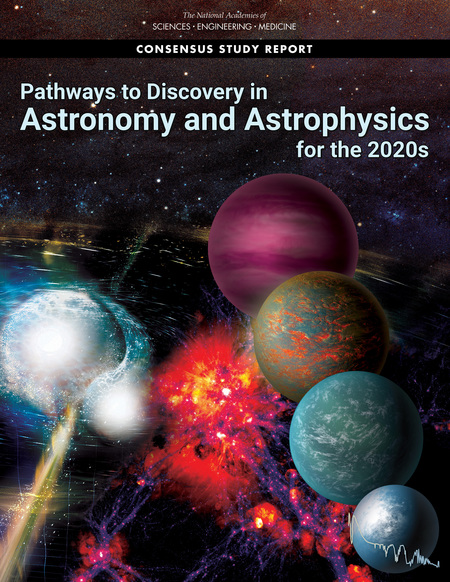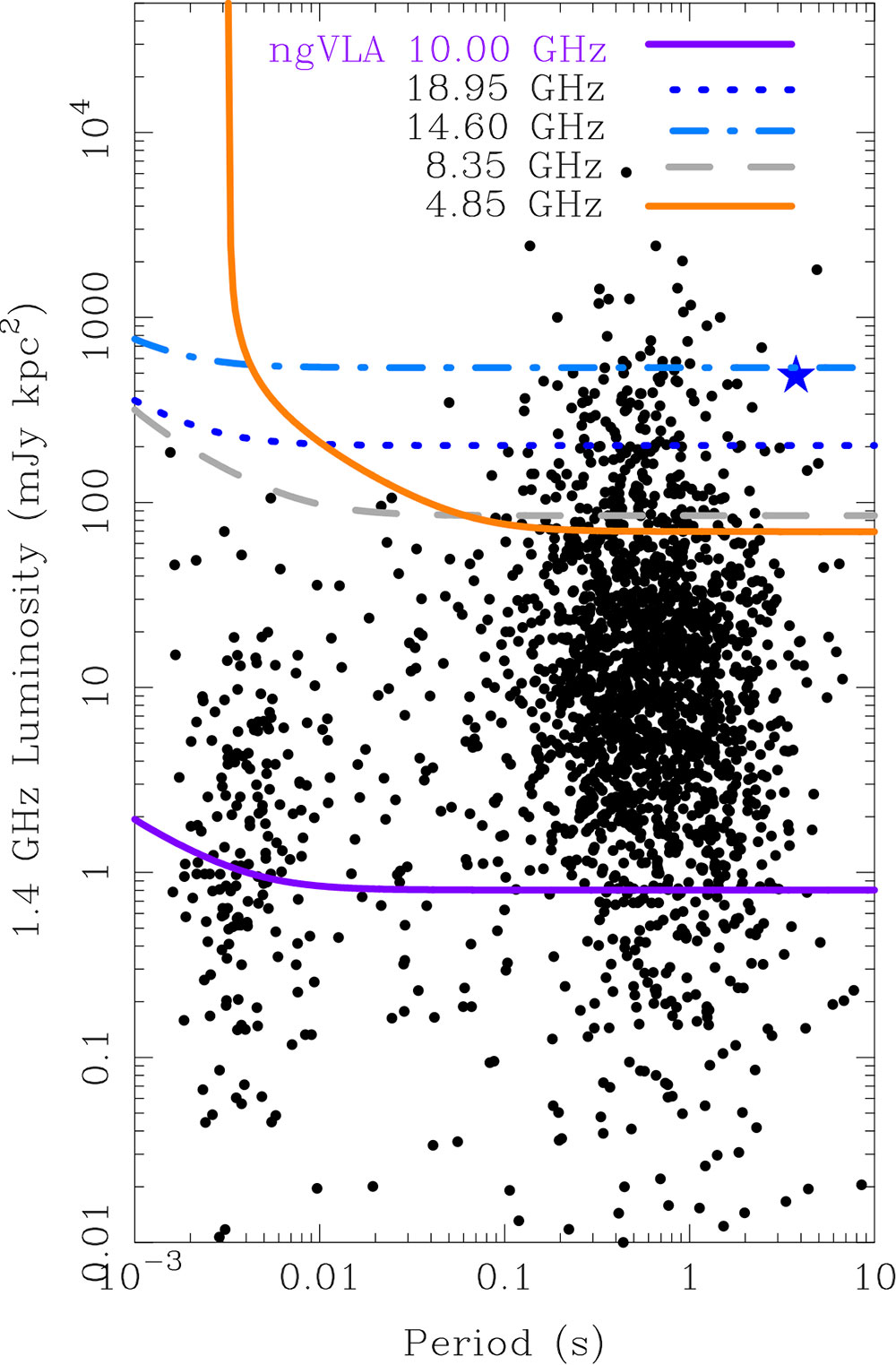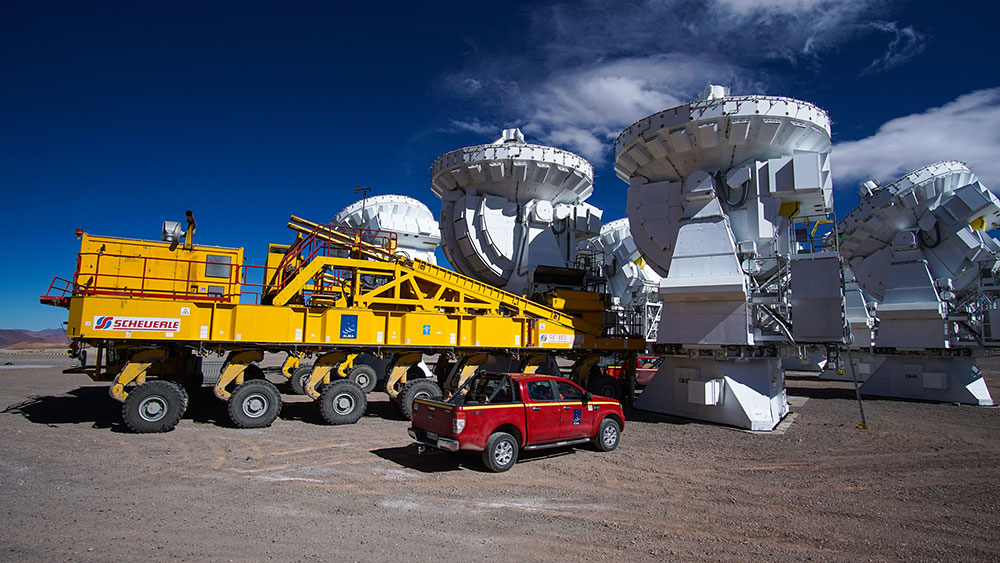NRAO eNews
Volume Vol#, Issue Iss#
Day# Month# Year#
NRAO eNews
Volume Vol#, Issue Iss# • Day# Month# Year#

Upcoming Events

Jansky Lecture: Prof. Luis F. Rodriguez
Nov 17, 2021 | Virtual

Jansky Lecture: Prof. Luis F. Rodriguez
Nov 19, 2021 | Virtual

37th Annual New Mexico Symposium
Nov 19, 2021 | Virtual

NRAO Town Hall
Jan 11, 2022 | Salt Lake City, UT

ALMA Special Session: ALMA Status & Plans for Increased Capability
Jan 13, 2022 | Salt Lake City, UT

ngVLA Special Session: Chemical Probes of Astrophysical Systems
Jan 13, 2022 | Salt Lake City, UT

Community Webinar Series: VLA/VLBA Call for Proposals Update for Semester 2022B
Jan 20, 2022 | Virtual
Astro2020 Strongly Endorses ngVLA

The National Academies Press
[click to enlarge]
The Astronomy and Astrophysics Decadal Survey (Astro2020) of the U.S. National Academy of Sciences has published its report and the Next Generation Very Large Array (ngVLA) received high priority for new ground-based observatories to be constructed during the coming decade. The report, in which ngVLA shared second ranking among ground-based projects, was the culmination of a lengthy process aimed at developing a comprehensive research strategy and vision for a decade of transformative science at the frontiers of astronomy and astrophysics.
The ngVLA is a system of 263 dish antennas spread across the entire extent of North America and concentrated in the U.S. Southwest that will provide dramatic new scientific capabilities to the world’s astronomers. The Astro2020 report led the ground-based facility list with the U.S. Extremely Large Telescope Project (US-ELT), a plan for two large optical telescopes—the Thirty Meter Telescope and the Giant Magellan Telescope, both under different stages of construction. After US-ELT, equal priority was given for development and construction for the ngVLA and the Cosmic Microwave Background Stage-4 experiment.
With the publication of the Astro2020 report, the ngVLA next will require approval by the National Science Foundation’s National Science Board and funding by Congress. Construction could begin by 2026 with early scientific observations starting in 2029 and full scientific operations by 2035.
The ngVLA is a resource for all astronomers, regardless of their institution or background. It will be accessible to all segments of the research community. Anyone will be able to submit an observing proposal to take advantage of the ngVLA’s advanced capabilities for frontier science. See the NRAO press release for additional information.
The Search for Pulsars in the Galactic Center

1.4 GHz luminosity versus spin period of the known pulsar population (black dots). Frequencies for the 100-m are labelled in black and for the ngVLA in purple. Luminosity limits of GC pulsar searches at each frequency are plotted as colored lines, after scaling to an average pulsar spectral index and the GC distance. Pulsars above a given line would be detected with a S/N of at least 10. Figure adapted from Eatough et al. (2021).
[click to enlarge]
Binary pulsars provide remarkably precise natural laboratories for exploring gravitational physics (Kramer 2016). The detection of even a relatively slowly spinning pulsar orbiting Sgr A*–the supermassive black hole at the center of the Galaxy–would yield a system that can be used to measure the fundamental properties of black holes as predicted by general relativity (Psaltis et al. 2016), and in a regime different to that measured with gravitational wave detectors (Kramer 2016).
Pulsars in the Galactic Center (GC) are also unique tracers of the magnetized interstellar medium and star formation history in this extreme environment. For these reasons, astronomers have been searching for GC pulsars, in earnest, for over a quarter of a century. Despite indications that a large number of pulsars should exist in this region (Wharton et al. 2012), only a modest haul of six pulsars has been detected within 0.5 degrees (~70 pc in projection) of Sgr A*.
In Eatough et al. (2021), a series of GC pulsar searches are presented at high frequencies compared to the 1.4 GHz typical for pulsar observing; see the figure. The 100-m Effelsberg telescope of the Max Planck Institute for Radio Astronomy (MPIfR) was used over four years, on multiple occasions and at four frequencies. This observing strategy was chosen to mitigate factors detrimental to the detection of GC pulsars, such as high levels of pulse scattering, strong background emission, and secular effects like relativistic spin precession or pulse nulling. Eatough et al. also used computationally intensive binary-pulsar search algorithms since the high stellar density of the GC implies binary pulsars should be commonplace.
In nearly 150 hours of independent observations, no new pulsar discoveries were made. Through calibration of the observing system it is shown that the sensitivity to GC pulsars is still low, likely due to a combination of effects such as strong contributions to the system temperature from GC background sources within the telescope beam, the steep emission spectra of pulsars, and the large distance to the GC. As such, Eatough et al. conclude that future instruments, in particular the ngVLA with its high instantaneous sensitivity, beamforming capability on small angular scales, and wide frequency coverage, is the ideal instrument to uncover the GC pulsar population. The ngVLA sensitivity would also enable extremely precise pulsar timing measurements of GC pulsars (or indeed pulsars elsewhere in the Galaxy!), where the uncertainty in time of arrival measurements scales inversely with collecting area (Bower et al. 2018).
Since 2015 the acronym ngVLA has appeared in 700+ publications indexed in the SAO/NASA Astrophysics Data System. This article continues a regular feature intended to showcase some of those publications. We are especially interested in showcasing work done by early-career researchers. The collection of showcase articles can be viewed online. Anyone wishing to volunteer to author a feature should contact Joan Wrobel.
Science Ready Data Products & the NRAO Archive
The Science Ready Data Products (SRDP) Program and the Data Management and Software Department are pleased to announce the release of an updated version of the new NRAO Archive. Version 4 of the NRAO archive is online and now offers the ability to view archived images online with the Cube Analysis and Rendering Tool for Astronomy viewer. Users view the images within their web browser, without downloading data to their local computer. Images from the Very Large Array Sky Survey (currently Epochs 1.1, 1.2, and 2.1), and images generated with Atacama Large Millimeter/submillimeter (ALMA) User-Driven Imaging (AUDI) can be viewed with CARTA. Users can select single or multiple images for viewing within a single CARTA session.
Along with the new features, data holdings from the legacy NRAO archive are being migrated to the new archive. All post-upgrade VLA data, all historical VLA data, most VLBA data, and Green Bank Telescope data from 2014 and later are available in the new archive. The remaining few critical features of the legacy archive that are not currently in the new archive will be migrated in the coming months and the new NRAO archive will soon replace the legacy archive.
The NRAO archive is also the interface to the user-facing features of the NRAO Science Ready Data Products initiative. Users can download calibrated measurement sets from the VLA (August 2016 and later) and ALMA observations (Cycle 5 and later). Furthermore, since 2019 an increasing fraction of VLA continuum data sets are quality assured and are ready for imaging. Quality assurance is currently performed on all C-band and higher frequency (and multi-band) continuum data sets that have standard calibration setups. Users can also create new data cubes and continuum images for ALMA projects (Cycle 5 and later) using the AUDI service. The frequency range, spectral averaging, and angular resolution of the images are all customizable within the limits allowed by the data. A similar imaging service is expected to be launched for VLA continuum data within the next six months.
Additional SRDP program information is online. Users with questions or problems accessing data within the NRAO archive should contact the science help desk.
ALMA Program News

Pablo Carrillo
An ALMA transporter returns a 7m antenna to the Atacama Compact Array after transport from the Operations Support Facility upon completion of its ten-year maintenance.
[click to enlarge]
Joint ALMA Observatory Continues Cycle 8
Cycle 8 observations have begun. The antenna configuration has moved back to C-7, with an expectation to reach C-6 proper around 1 December. The first Cycle 8 data sets have already been delivered to the respective Principal Investigators.
Special Session at the winter American Astronomical Society meeting
ALMA continually upgrades its capabilities. A new set of receivers covering the 35 to 50 GHz band (Band 1) is being installed on antennas at ALMA and has achieved first light. With this milestone, ALMA set a new record for the longest wavelengths visible with the radio array and has opened a window on the Universe previously inaccessible at the telescope, thanks to an international team of engineers led by ALMA–East Asia, including engineers from the National Radio Astronomy Observatory (NRAO).
Band 2 (67-116 GHz) is in late stages of development by another international team led by ALMA–Europe. ALMA–North America has proposed an upgrade of the most-used 1.3mm band, Band 6, to increase its sensitivity and bandwidth coverage. Other upgrades are planned to accommodate these new receiver capabilities, including to the correlator.
A Special Session at the winter American Astronomical Society meeting–13 January 2022, 2-3 p.m. MST–will describe ALMA news, capabilities, and expectations for ALMA performance and science in the next few years, and plans for its upgrade in the 2030 timeframe.
Recent Media Releases
From the Archives
Ellen Bouton

[click to enlarge]
About this month's photo: NRAO employees have often participated, either individually or as a team, in various community walks/runs, including Walk for Alzheimer's, 4 Our Freedom 5K, Tough Mudder, Spartan Race, and other locally organized events. This photo is of NRAO participants in the 4 October 1998 American Heart Association Walk in Charlottesville. Standing l-r: Joe McMullin, Jack Gallimore, Tessy Schlemerer. Seated l-r: Michelle Thornley, Mary Gallagher, Billi Jo Mattox.
From the Archives is an ongoing series illustrating NRAO and U.S. radio astronomy history via images selected from our collections of individuals' and institutional papers. If readers have images they believe would be of interest to the Archives, please contact Ellen Bouton.

